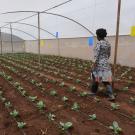This presentation available to watch on video or to listen to via audio to was shared on September 20, 2017 at the annual American Society for Horticulture Science conference in Waikoloa, Hawaii by Thibaud Martin, Laurent Parrot, Emilie Deletre, James Simon and William Vance Baird for the Horticulture Innovation Lab project "Assessing feasibility of pest-exclusion nets in Kenya."
Abstract
The use of Insect Exclusion Netting (IEN) to protect vegetables in tropical areas leads to increased yields (with a higher percentage of marketable produce), while significantly reducing the use of synthetic insecticides or eliminating their application altogether. As such, the use of netting technology has generated significant interest among growers (particularly smallholder farmers), grower associations and netting manufacturers. The use of such IEN with green bean, tomato and other high value vegetable crops is of particular interest as this technology can be combined with biological control methods – enhancing exporter compliance with increasingly more-strict pesticide minimum residue levels. Although some growers now use and promote IEN, questions remain to be answered to better predict the probability of success for their broader and long-term adoption. Given the promise that this technology holds to improve crop yields and quality, and thus farmer profits, our team (in concert with the Horticulture Innovation Lab, U.C. Davis) met with Kenyan exporters, grower groups, smallholder farmers, private sector partners including commercial net manufacturer and biological control agent providers to help identify what is needed to determine if IEN are appropriate to scale-up; as well as what information gaps exist in order to judge the potential for scale-up. This will be accomplished through observations, discussions and by listening to lessons learned by those using this technology. To do so, high tunnels/net-houses covered by AgroZ® Net were deployed in 30 smallholder farmer fields, which address three key concerns: (1) the return on investment in relationship to crops grown (e.g., green bean, tomato and/or cabbage); (2) barriers to sustained adoption of the technology, including (a) broad awareness of the technology’s availability and potential impact, (b) grower access to innovative loan or savings programs that provide the investment capital needed to purchase the technology; and (3) the long-term commitment and investment by the prime partner manufacturer to provide the IEN and addressing future designs improvements. In addition, secondary issues that have been addressed include (i) the optimum physical design and engineering of support structures such as tunnels and net-house kits; (ii) the range of specialty crop that can be profitably grown under the nets; and (iii) the cost-effectiveness of combining proven biological control agents with net technology.
Link to audio file of presentation on the American Society for Horticultural Science's website

